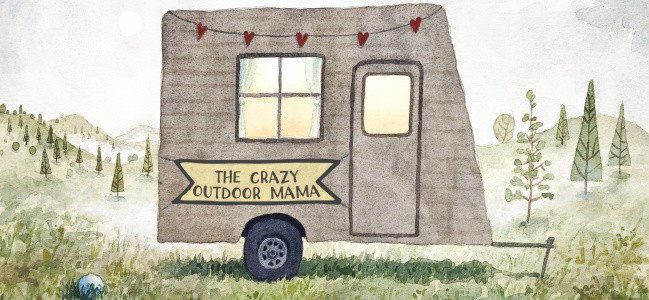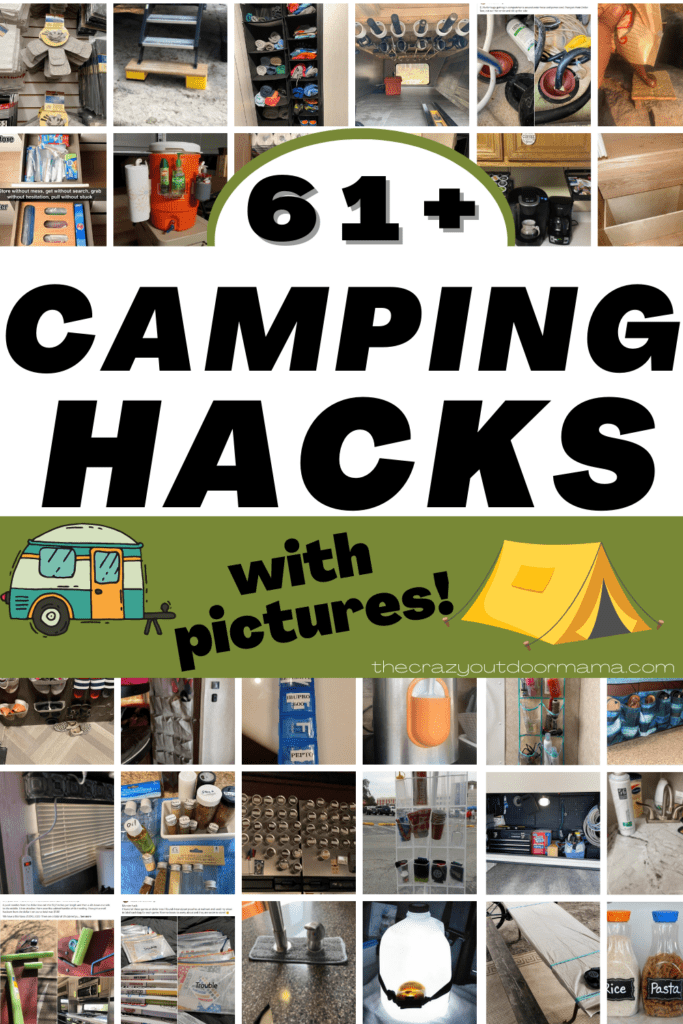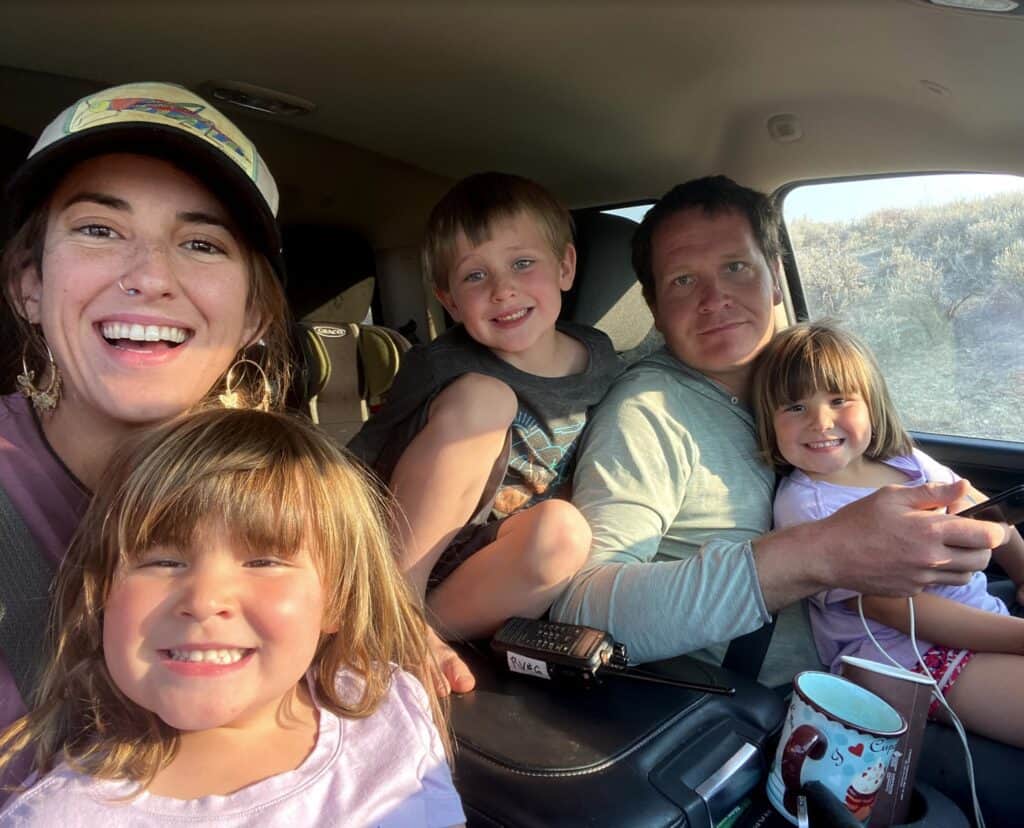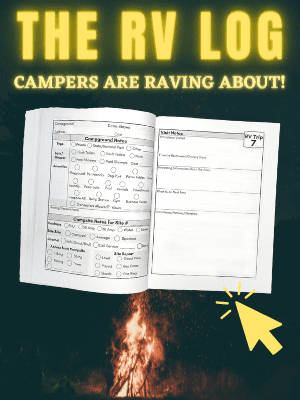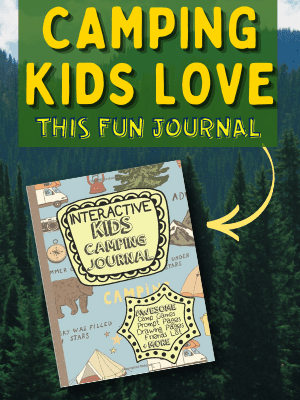Boondocking is one of the most exciting things you can do in your RV. It does take some extra planning and time, but boondocking spots will get you some of the best views and most secluded wild camping there is.
Boondocking might seem scary if you’re a newbie, but as long as you follow some general guidelines, you’ll be just fine (and the Instagram-worthy views will be totally worth it).
So here’s my complete guide to boondocking, everything from what you should plan beforehand, to safety guidelines, boondocking tips and tricks, and all the gear you need to go boondocking.
Let’s jump right in!
But first, what is boondocking??
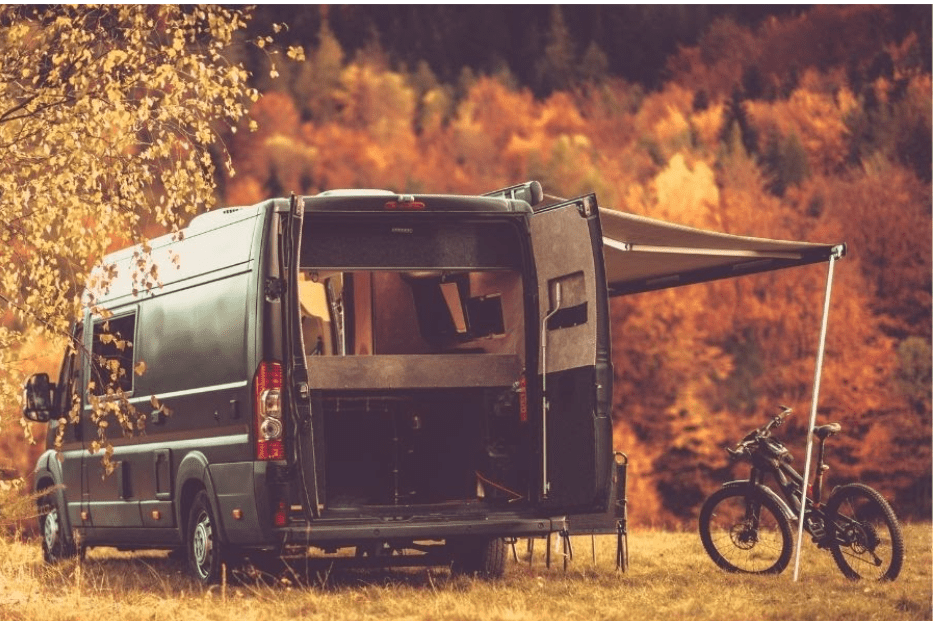
Table of Contents
What is Boondocking in an RV?
Boondocking really just means going RV camping where you don’t have any hookups. So, no sewer, water, or electricity.
Boondocking usually refers to free camping on public land–National Forest Service (NFS), or Bureau of Land Management (BLM) land–on undeveloped, dispersed campsites. It can also be as simple as overnight parking in a Walmart parking lot.
You may also hear boondocking referred to as “dry camping” or “dispersed camping”.
Technically dry camping just means camping without water, so you could be dry camping at developed campgrounds if you don’t have a water hookup. Dispersed camping just means camping outside of a developed campground–which is what boondocking is!
What To Know Before You Go Boondocking
Since you’ll be camping without any hookups, there’s a little extra planning that goes into boondocking compared to camping at developed campgrounds. Here’s what you should have all figured out before you leave for your adventure…
Related – Check out these 9 tips to make your boondocking trip a success!
How Long You’ll Be Gone
The difference between camping overnight and camping for two weeks straight is HUGE. Plan exactly how long you want to stay at your site so you can ensure you’re bringing enough food and water (plus a little extra).
The Weather Forecast
One of the first things you look at before you head out should be the weather forecast. If there’s going to be a lot of snow or rain, or it’s going to be really cold or really hot, boondocking at this time may not be safe.
Snow and rain increase the risk of you getting stuck at your site. And extreme temperatures mean you’ll have to use more power than you might be able to generate.
The Exact Location of Your Spot
Make sure you know exactly where you’re going when boondocking. Most apps will give you exact coordinates, so this makes it super simple.
There’s nothing worse than showing up near a site and losing service, or being unable to find the site and having to turn around and go somewhere else. It’s also a good idea to call the local park ranger or BLM office ahead of time to make sure your spot is open and accessible.
Closest Amenities
It’s good to know where your nearest gas station is so that in an emergency, you can leave your site to fill up with gas or get extra food and water.
How to Get Electricity While Boondocking
Generators
Many RVers opt to purchase generators to use while boondocking if their RV doesn’t already come with one. Generators generate electricity to power your lights, appliances, and electronic devices by burning fuel.
Generators are known for being pretty loud, but you can find some quieter ones so you can spend more time enjoying the sounds of the outdoors. This one from Westinghouse is pretty quiet and uses propane or gasoline.
It’s powerful enough to power your a/c or heater, plus your appliances. But if you don’t need something that packs that much of a punch, there are plenty of smaller ones on the market.
Check out my article on the 13 best quiet RV generators to look at more options.
Solar Batteries
Solar power is becoming a wayyy more popular choice for boondockers in recent years because solar panels and batteries are cheaper and more efficient than they’ve ever been.
Solar batteries are also completely silent, way better for the environment, and you don’t ever need to refill gas or propane. So, many boondockers see solar power as a better option overall.
However, solar power does have some downsides. For one, you need to be parked in an area that gets direct sunlight for at least a few hours per day for your solar panels to generate electricity. Plus even with full sun, solar batteries usually will not be able to power as much as a large generator would.
If you do want to go solar, the Goal Zero Yeti 1000 is a really popular choice for boondockers. Basically, you purchase this battery, hook it up to solar panels on top of your rig, and boom! You’re making electricity from the sun!
What About Water While Boondocking?
Water is your most important resource while boondocking, and my biggest tip here is to conserve as much as possible and use freshwater sources when you can.
Before you go: Fill up your water tank! All the way. If you’re going on a long trip, bring extra water jugs, or a water bladder so you can really stock up.
While you’re there: Like I said, conserve water as much as possible. This means not showering every day and using freshwater sources around you (make sure to use biodegradable soaps or shampoos), while conserving the water in your holding tank for drinking.
If you run out: Make sure you know where your nearest amenities are so you can go replenish your water supply if you need to.
And if worse comes to worst and you’re getting low on drinking water while in the middle of nowhere, follow these tips to purify water.
Related: If there’s a water source nearby, you could also try purifying your own water!
Where Do I Dump My Waste?
There are a few options for what to do with your waste, but first I want to make it clear that you should never ever dump the chemically-treated waste from your black tank out in the woods. This can seriously harm plants, animals, and freshwater sources.
Now that I’ve got that out of the way, what should you do with your waste while boondocking?
Bury It
Well, if you aren’t going to be staying for long and you don’t want to use up water by flushing your toilet, you can use the restroom outside! Just make sure you walk well away from your campsite and freshwater sources (at least 200 feet) and dig at least 6 inches into the ground.
Use Dump Stations
If you aren’t staying for very long, just clean out your black tank before you go, use it while you’re boondocking, and empty it at a dump station after your trip.
If you are staying a long time and still want to use the toilet, you can drive your rig into town, dump it at a gas station or other dumping station, and head on back to your camp. You can stock up on other necessary supplies while you’re there too.
However, going to dump stations can be a hassle as many boondocking sites are difficult to get in and out of, and far away from amenities. So, I propose my next option…
Use a Composting Toilet
Yay composting toilets! These are super popular in the boondocking community because you can use them for way longer than you can a flushable toilet and black tank without having to dump or clean out anything. AND they don’t use ANY water!! Huge plus for boondocking.
Plus, the waste that is in the toilet is safe to be buried at a boondocking site if necessary because there aren’t any excess chemicals in it.
Composting toilets might seem intimidating at first, but they can make boondocking life easier, and they don’t smell unless there’s a problem. If you’re brave enough to switch to a composting toilet, I really don’t think you’ll regret it.
If you want to make the switch, check out these 7 best portable composting toilets to find the best option for you.
Internet While Boondocking – a Must If You Work on the Road!
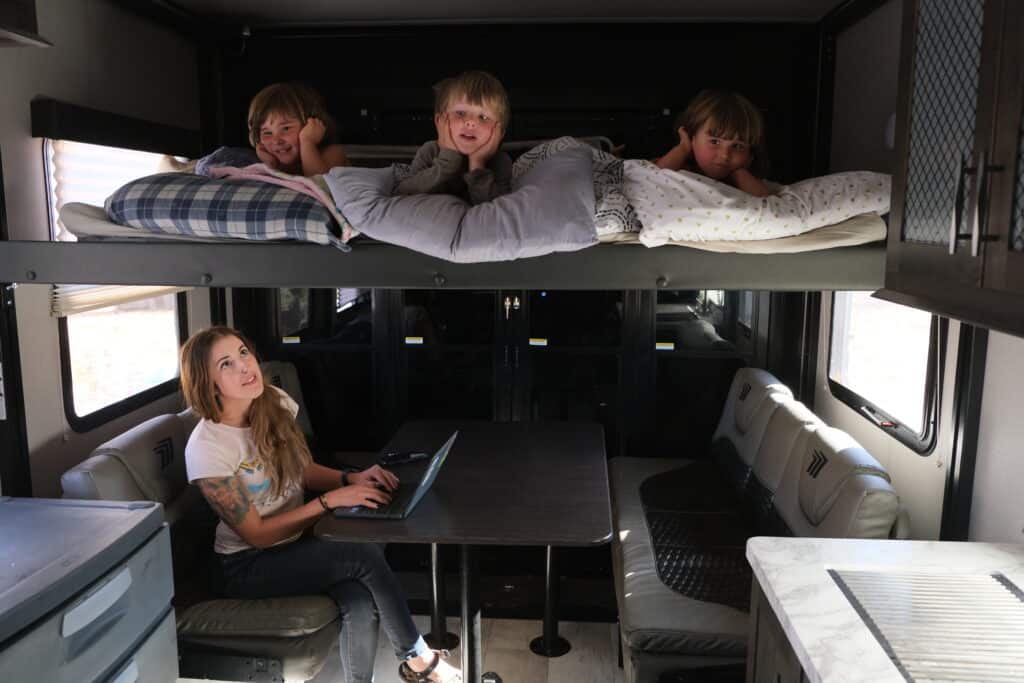
Fear not! You can get internet while boondocking. You just might need a few tools. Internet while boondocking is all about cellular data–WiFi is pretty much nonexistent on BLM and NFS land, so don’t expect to be able to rely on public WiFi while boondocking.
That being said, here’s how you can get internet using a cellular data plan while boondocking.
Check Coverage Maps
First of all, you need to decide what cell phone data provider to get. Look at a map provided by carriers or on a mobile app like Open Signal to see what providers cover what areas. If you already have a plan, you can use this to see if you should expect a signal where you’re going, and how strong that signal will be.
For dispersed camping on BLM and NFS land in the Western U.S., Verizon tends to have the best coverage, but AT&T is in second.
Getting WiFi With a Cellular Data Plan
To get connected to the internet using cellular data, you need two things:
- A cellular data plan
- A mobile WiFi hotspot
Simply pick your plan from a carrier and connect your mobile hotspot to that data plan. If you’re in an area that has cellular data service, all your devices can connect and you’ll have internet!
Using a Cellular Data Booster
A lot of areas have a cellular data signal, but it’s not strong enough to support things like streaming videos (or scrolling through Instagram).
Some RVers opt to strengthen this signal by using a cellular data booster like this one from WeBoost.
These work by capturing an existing cellular data signal and boosting it so you can browse Instagram all you want.
If you have more questions on getting WiFi, check out my complete guide to RV WiFi.
How to Stay Safe While Boondocking
Boondocking is generally a bit riskier than camping in RV parks because of things like inclement weather, wildlife, and little cell reception. But don’t get spooked! If you practice boondocking safely you’ll be just fine.
Have a Safety Contact
If you’re going somewhere you know you won’t have service, contact a friend or family member and give them the exact coordinates of where you’ll be staying, and how long you expect to be gone.
Pack More Than You Think You Need
Especially for longer trips, pack at least an extra day’s worth of water and food in case you get stuck for whatever reason. Always lean on the side of having too much rather than not enough. It’ll help give you some peace of mind while you’re out in the sticks.
Practice Wildlife Safety
When you’re wild camping, you’re basically encroaching on animals’ territory. So, you run the risk of finding yourself face to face with bears, elks, mountain lions, and other animals.
Do your best to keep food inside as much as possible, and always pack food away inside of your RV at night. If you do see a wild animal do not approach it and do not feed it. And of course, don’t leave any food, garbage, or anything that wasn’t there when you got there at your boondocking site.
Bring a Satellite Transponder
If you’ll be gone for a long time, and possibly doing some backcountry camping or hikes while you’re boondocking, it might be a good idea to bring an emergency satellite beacon. If you get lost, these will send an SOS call to local police or EMS so you can get out of there safely.
What Types of RVs Are Good For Boondocking?
An RV that’s great for boondocking might have some of the following features — you don’t have to check all the boxes here, but try to look for these features if you’re interested in an RV for boondocking:
- RVs with solar
- Smaller, lightweight RVs
- High clearance
- High-capacity holding tanks
Technically, you can boondock in your Class A, but some spots might be completely inaccessible to you. In my experience, the rougher the drive, the better the view when you get there. So having an RV that is pretty rugged will help you get to every boondocking site you want to go to.
Here’s a couple examples…
For a travel trailer, the Jayco Jay Feather Micro seems to be a great bet.
It’s a nice medium-sized trailer so you’ll still get all your amenities (kitchen, bathroom, etc.), but it’s still lightweight. Jayco offers a package with solar-prep and a shock-absorbing torsion axle that makes it great for off-roading.
If you want something more stripped-down, and way more rugged… I present the awesome Sunnyside OffRoad Boony Stomper.
This is a great super rugged, stripped-down trailer that really only has a bed inside and it’s perfect for getting to the most difficult boondocking spots there are.
Check out my list of the best off-road camper trailers for a full review of the Boony Stomper plus some more ideas for boondocking trailers.
Boondocking Etiquette
There are definitely some unwritten rules when it comes to boondocking, but you should absolutely follow all of these, for the safety of yourself and the environment, and out of respect to other campers.
Call Ahead
Whether you’re overnight parking at a grocery store, or you’re in the middle of BLM land, call ahead of time to make sure it’s okay you stay there.
Also, ask the limit for how long you can stay. Most NFS and BLM land has a stay limit of 14 days. Wherever you go, make sure you don’t exceed the stay limit.
Stay Quiet
Wherever you are, don’t be too noisy out of respect for people and wildlife around you. Try to maintain the etiquette you’d have at an RV park and try to stay pretty quiet at night time.
Easy on The Lights
You don’t want to be blinding animals or other campers at your wild camping spot, so try to use dimmer lights at night. Many boondockers even have blackout curtains so that no light can be seen coming from inside their RV.
Take Nothing, Leave Nothing
Always practice “leave no trace” when boondocking. This means don’t leave garbage, pet waste, a visible firepit where there wasn’t one before, or anything else. Stay on designated trails and don’t take home any rocks or plants as souvenirs.
Free camping on public land is an awesome opportunity for us campers, so we want to be super respectful of the land.
Stay Only Where You’re Allowed to Stay
Lots of free camping spots on public land border privately-owned land, but it can be hard to tell where one ends and the other begins. Typically there will be a fence between public and private land, but I recommend just staying around your chosen primitive camping area out of respect to the owners of any neighboring private property.
Where to Find RV Boondocking Sites
There are tons of places to boondock, but you really just know how to find them. You can boondock at places like Walmart and Costco, at truck stops, some rest areas, trailheads, visitors centers, hotels, and on public land.
But how do you know where the best sites are?
If you’re planning on boondocking, you should definitely have a toolbox of apps and websites on hand to find the best site available near you. Not only do these apps and websites help you locate your site, but they also have reviews and photos so you can find those Instagram-worthy views.
Let’s talk about those apps and websites now!
The Best Boondocking Apps And Websites
There are tons of boondocking apps and websites out there. You don’t need them all, but I recommend having a few on hand.
When I’m boondocking, I like to check 2-3 apps on my phone until I can really find the best spot. There’s a good amount of overlap between the apps but they’ll all have different photos, reviews, and unique sites to browse through.
iOverlander
iOverlander is an app for Android and iOS, and also a website where you can find great free camping all over the world. This app happens to be my favorite simply because I’ve found some really gorgeous campsites using this app.
Just sort by “free”, read reviews, and look at photos to find the best campsite near you.
Campendium
Campendium is an RVer tried-and-true app that shows free and paid campsites all over the U.S. It’s very similar to iOverlander as it has apps for Android and iOS, as well as a website, and you can sort by “free” or “public” campsites and read reviews to find one near you.
I find Campendium to have slightly fewer sites compared to iOverlander, but I have been able to find some gems with this app.
FreeCampsites.net
Freecampsites.net is another great resource to have as a boondocker. I’ve found many beautiful dispersed campsites on this website. I really like that the website allows you to read through reviews for each site, and users give the sites a star rating out of five which helps you sort through and find the very best camp spot near you.
Gear You Need for Boondocking
Boondocking comes with some unique challenges that might call for some extra gear you should pack along with you. So, here are some of my recommendations for necessary boondocking gear…
An Emergency Kit
Boondocking comes with extra risks that you may not have to deal with when camping at RV parks, so taking extra precautions for safety is super important. Having a first aid or emergency kit is definitely an essential for boondocking.
Whether you decide to make your own emergency kit, or purchase one like this, this is a must-have item for your boondocking gear list.
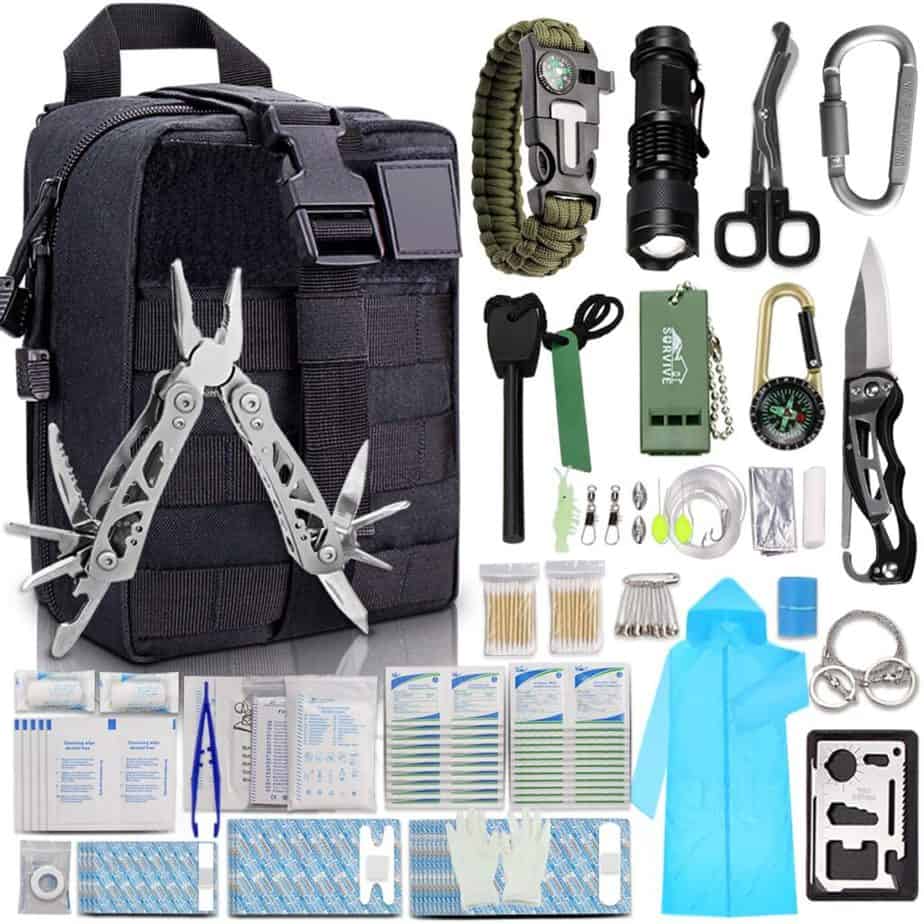
Extra Water Storage
If you’re going boondocking for an extended time, or if your RV’s fresh water tank capacity isn’t large enough, you’re going to need extra ways to store your water.
If you need to bring lots of extra water, you can invest in a water bladder, which is basically just a huge bag that holds tons of water. (The AQUA TANK offers a capacity of up to 150 gallons!!!)
If you just need some extra water in case of an emergency, you can buy gallons of water from the grocery store, or get a refillable water container from any outdoor store.
Water Saving Shower
Again, when you’re boondocking, water is your most important resource and conserving it should be a top priority.
Hardcore boondockers don’t shower at all while they’re boondocking and stick to wipes instead. But that’s not everyone’s cup o’ tea. Plus, that’s not totally necessary as long as you shower quickly and space out your showers.
If your RV has a shower, try replacing the showerhead with a water-saving faucet like this one from Delta.
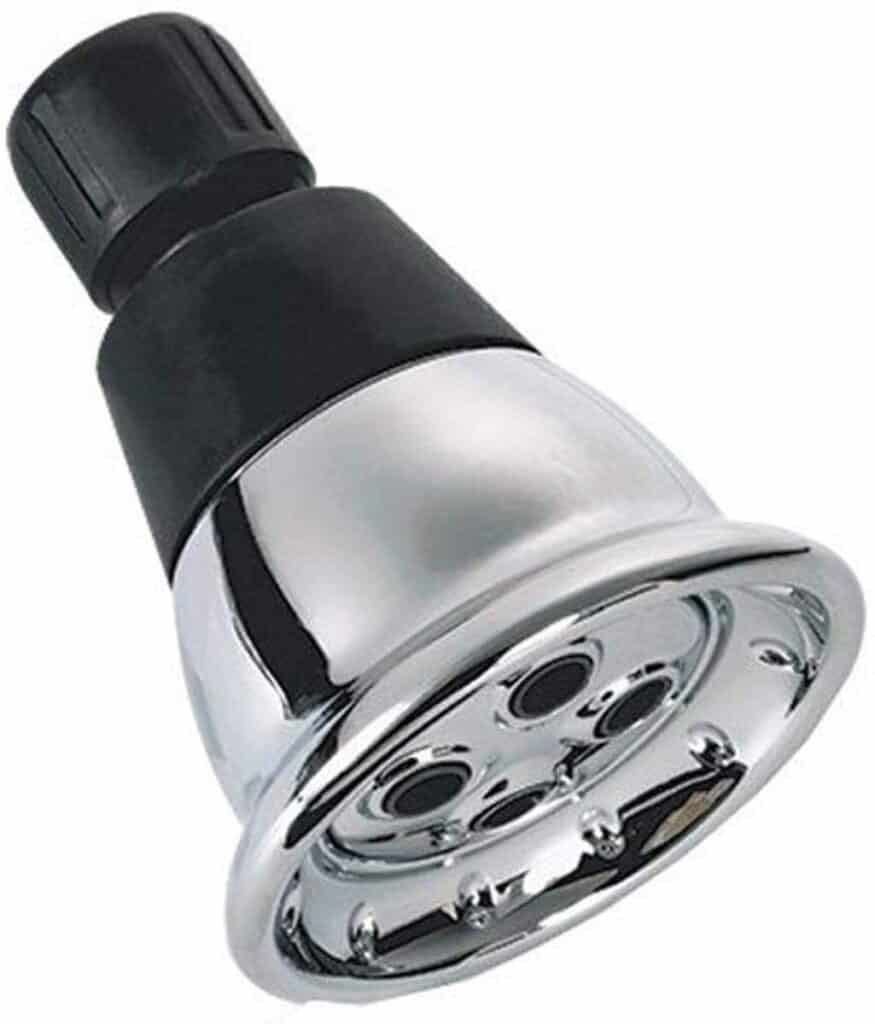
Showerheads like this one will help you significantly decrease your water usage but you can still stay clean while you’re in the boonies.
If you don’t have a shower in your RV, or you’d like to shower in the great outdoors, a camping shower like this NEMO one is a fun option.
For this one, you just pump it up with your foot to pressurize the water. This will help you use significantly less water than showering, even with a water-saving showerhead. Plus, you can also use it for washing dishes and brushing your teeth.
Looking for more RV gear? Check out my list of 55 helpful RV gadgets!
Common Questions About Boondocking
Is boondocking legal?
Yes, but only in certain areas.
Boondocking is legal anywhere on BLM land and land owned by the National Forest Service. But call ahead to make sure the area you want to camp in is open–roads are often closed due to weather or maintenance. Boondocking is also legal in business parking lots like Walmart, and Costco, but again, just call ahead just to make sure they’re OK with you staying the night.
Is boondocking free?
Usually boondocking is free, yes.
Some dispersed campsites will charge you per night (it’s usually pretty cheap). But the vast majority of boondocking sites are completely free.
How long can you boondock for?
You can boondock for up to 14 days on BLM and National Forest Service land. How long you can stay at a business will vary from place to place, so call and ask how long they’ll let you stay.
Is boondocking safe?
Boondocking is actually very safe, given you follow some basic guidelines like practicing wildlife safety, checking the weather forecast, and packing extra supplies.
Can you boondock in national parks?
Boondocking is not generally allowed in any national parks. Instead, national parks have designated camping areas with amenities and they’ll charge you a nightly fee. Some national parks allow tent camping (backcountry camping) within the park but usually require a permit.
Ready to Try Boondocking?
That’s a wrap! Whether you’re going boondocking overnight, or for two weeks, make sure to always take extra safety precautions, bring extra supplies, and make sure you’re allowed to camp at the site you’ve chosen.
Even with all this extra work, though, boondocking is totally worth it because it allows you to save money while taking in some beautiful views far away from some loud and crowded RV park.
Safe travels and check out some of my other articles for more boondocking and RVing advice!
- 9 Things You NEED To Know Before Boondocking in Your Camper!
- 9 Essential Tips to Rock Overnight Parking Your RV
- 13 Best Quiet RV Generators (2021) for Camping in Peace
- How to DIY RV BlackOut Window Covers for Your RV or Camper (NO SEWING Involved!)
- 11 Most Helpful Outdoor RV Products That You Don’t Need… But Will Make Your Camp Trip WAY Nicer!
- Solar Eclipse 2024 Kids Printable Activity Pack! - April 8, 2024
- 11 RV Bathroom Makeovers to Inspire You! - April 7, 2024
- 13 Dreamy Hammock Camping Set Up Ideas + Pics - February 22, 2024
